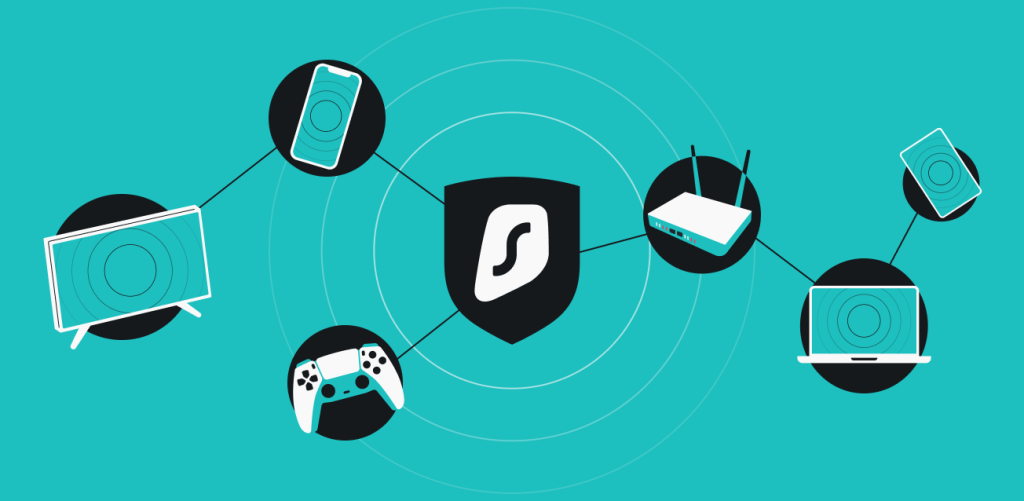
WireGuard is a modern VPN (Virtual Private Network) protocol that has become the industry standard for secure, fast internet connections. Designed with simplicity and performance in mind, it offers exceptional speed while maintaining strong security through modern cryptographic solutions.
But does WireGuard fundamentally change what a VPN can do? Does it offer more security than its predecessors? And does the choice of protocol impact you, the user, at all? Let’s take a look.
Table of contents
What is WireGuard VPN?
WireGuard is a streamlined VPN protocol designed specifically for speed, security, and simplicity. Unlike older protocols with complex codebases, WireGuard uses only about 4,000 lines of code, making it easier to audit for security vulnerabilities and simpler to implement across platforms.
WireGuard’s key features:
- Exceptional performance and low latency;
- Modern cryptographic algorithms for strong security;
- Cross-platform compatibility (Windows, macOS, iOS, Android, Linux);
- Simplified configuration and setup.
How WireGuard works
WireGuard creates secure point-to-point connections using a straightforward process:
- Key generation: creates cryptographic key pairs (private key stays on your device, public key shares with the VPN server).
- Secure tunnel establishment: your device and VPN server exchange public keys to create an authenticated connection.
- Data encryption: all transmitted data is encrypted and authenticated to prevent tampering.
- Efficient routing: assigns static IP addresses within the VPN network for consistent connectivity.
- Automatic reconnection: quickly re-establishes connections when networks change without manual intervention.
WireGuard’s cryptographic protocols
WireGuard employs a combination of modern cryptographic standards for security and efficiency, including:
- Noise Protocol Framework: establishes secure, authenticated communication channels;
- Curve25519: ensures secure key exchange that cannot be intercepted;
- ChaCha20: provides efficient data encryption, especially on mobile devices and routers;
- Poly1305: authenticates data to prevent tampering;
- BLAKE2: generates secure cryptographic hashes quickly;
- HKDF: derives unique encryption keys through solid cryptographic processes.
By combining these cryptographic standards, WireGuard achieves a high level of security while minimizing its impact on efficiency and performance.
Is WireGuard better than OpenVPN and IKEv2?
Before choosing a VPN protocol, it’s important to understand how different options compare. WireGuard, OpenVPN, and IKEv2/IPsec are all popular choices with strong security standards, but each has distinct strengths for different use cases.
WireGuard vs. OpenVPN
WireGuard | OpenVPN | |
|---|---|---|
Performance | Excellent speeds, low latency | Good speeds, higher latency |
Efficiency | Lightweight code, efficient on all devices | Larger codebase, can be less efficient |
Security | Modern cryptography (ChaCha20, Poly1305) | Strong encryption (AES), mature but complex |
When WireGuard wins: WireGuard excels in speed, efficiency, and simplicity. Its streamlined design and modern cryptography deliver faster data transfers with lower latency, making it ideal for streaming, gaming, and general browsing. The setup process is straightforward, even for less technical users.
When OpenVPN might be better: OpenVPN offers extensive configurability and advanced features that WireGuard currently lacks. Its rich ecosystem of plugins enables traffic obfuscation (masking VPN connections as regular HTTPS traffic), making it valuable for bypassing network restrictions. OpenVPN also provides more customization options for complex network environments.
WireGuard vs. IKEv2/IPsec
WireGuard | IKEv2/IPsec | |
|---|---|---|
Performance | Excellent speeds, low latency | Very good speeds, stable performance |
Network handling | Maintains connection when switching networks | Excellent stability, quick reconnection (MOBIKE) |
Setup | Simple configuration, user-friendly | Built-in support on most devices, but complex advanced setup |
When WireGuard wins: WireGuard offers superior speed and simpler configuration. Its modern cryptographic algorithms and streamlined codebase result in lower latency and faster connections. WireGuard also handles network changes efficiently, maintaining stable connections without drops.
When IKEv2/IPsec might be better: IKEv2/IPsec provides built-in support on most modern devices, eliminating the need for additional software installation. This makes it particularly convenient for users who prefer a native, straightforward setup without third-party applications.
Which protocol should you choose?

Choose WireGuard for maximum speed, simplicity, and modern security. It’s the best option for most users seeking fast, reliable VPN connections.
Choose OpenVPN if you need advanced customization, traffic obfuscation for restrictive networks, or extensive plugin functionality.
Choose IKEv2/IPsec if you prioritize built-in platform support and prefer avoiding additional software installation.
The pros and cons of WireGuard VPN
While WireGuard offers a compelling mix of speed, security, and efficiency, it’s important to also consider its limitations and whether or not they might impact your specific needs:
WireGuard pros
- Speed and efficiency: WireGuard delivers excellent performance with lower latency than traditional protocols, making it ideal for streaming, gaming, and video conferencing;
- Strong security: uses modern cryptographic algorithms and has fewer lines of code, reducing potential vulnerabilities compared to more complex protocols;
- Cross-platform support: works seamlessly across Windows, macOS, Linux, iOS, and Android with consistent performance;
- Network stability: excels at maintaining connections when switching between networks, with quick reconnection capabilities for mobile users;
- Simple configuration: easy setup process, even for less technical users, with minimal configuration requirements.
WireGuard cons
- Limited advanced features: compared to mature protocols like OpenVPN, WireGuard currently lacks some advanced configuration options and tunneling protocols;
- Newer technology: while stable and widely adopted, WireGuard continues active development, which may introduce changes affecting stability;
- VPN provider implementation: security depends on how VPN providers configure the protocol, as WireGuard itself stores IP addresses and doesn’t provide traffic obfuscation by default.
How to set up WireGuard with Surfshark
As WireGuard is a fairly new protocol, not all VPN services support it. Luckily, Surfshark has got you covered: you can easily enjoy the benefits of WireGuard VPN, both with automatic in-app configuration and manual setup options.
Automatic setup (recommended)
- Download and install the Surfshark app on your device.
- Log in with your Surfshark credentials — or register and subscribe to one of our plans.
- Navigate to Settings and choose VPN Settings followed by Protocol.
- Select WireGuard (often pre-selected automatically).
- Choose a server location and connect.
Manual configuration
If you prefer a more hands-on approach or need to set up WireGuard on a device that doesn’t support the Surfshark app, you can opt for manual configuration. Here’s how to go about it:
- Log into your Surfshark account.
- Navigate to the manual setup section.
- Generate cryptographic keys and download the configuration file.
- Install the WireGuard app from their official website or your device’s app store.
- Import the Surfshark configuration file.
- Activate the VPN tunnel.
WireGuard’s security and privacy
Although WireGuard provides strong security through modern cryptographic standards, implementation matters. While the protocol itself may store connected IP addresses and doesn’t obfuscate connections by default, reputable VPN providers like Surfshark address these concerns by:
- Never storing connected IP addresses;
- Assigning dynamic IP addresses to users;
- Adding connection obfuscation for enhanced privacy;
- Implementing additional security layers.
Platform availability
As a standalone, WireGuard offers extensive platform compatibility:
- Desktop: Windows, macOS, Linux (multiple distributions);
- Mobile: iOS, Android;
- Specialized systems: FreeBSD, OpenBSD, various router firmware;
- Surfshark app support: currently available on Windows, macOS, iOS, Android, and Linux.
For more information about the installation process, visit the WireGuard installation page.
Conclusion — get to know WireGuard at your own speed
WireGuard has established itself as the preferred VPN protocol for most users. While OpenVPN and IKEv2/IPsec remain viable for specific use cases, WireGuard’s modern design and exceptional performance make it the best choice for streaming, gaming, and mobile use.
If you’re looking to combine the benefits of WireGuard with comprehensive privacy protection, choose a reliable VPN provider like Surfshark. Properly implementing the protocol ensures you get cutting-edge performance and airtight security at the same time.
FAQ
Is WireGuard a VPN?
WireGuard is not a full VPN service on its own — it’s a VPN protocol. That means it provides the technology used to create secure, encrypted tunnels between devices. While it can be used as the foundation for a custom VPN setup (especially by tech-savvy users), most people encounter WireGuard as part of a VPN service that uses it under the hood for fast and secure connections.
Is WireGuard free?
Yes, WireGuard is free and open-source. It’s been designed with the intention of being freely implemented and used by VPN developers or tech-savvy privacy enthusiasts.
Does WireGuard mask your IP?
WireGuard doesn’t mask your IP address on its own, as it’s mainly used as a VPN protocol for secure communication. To mask your IP, you need to connect to a VPN service using WireGuard, which then assigns you a different IP address from its server network.
Can WireGuard be hacked?
VPN services can be hacked, but it’s exceptionally challenging. WireGuard protocol combined with AES or ChaCha encryption is almost impossible to decrypt using the most common hacking technique — brute force attacks.
Is WireGuard a good VPN protocol?
WireGuard is one of today’s safest, most secure VPN protocol options. Simplified design, modern cryptography, and superior default security settings make WireGuard stand out.
What port does WireGuard use?
WireGuard’s default port is 51820. If you wish to use additional tunnels, you must use a different port. The GUI (Graphical User Interface) will automatically suggest the next highest available port.
Does Surfshark work with WireGuard?
Yes! Surfshark has implemented WireGuard, and you can now use it in-app or configure it manually.
Why is WireGuard important?
WireGuard is important because it provides a fast, secure, and efficient VPN protocol that’s simpler and easier to audit than traditional VPN solutions. Its modern cryptographic design ensures robust privacy and security while maintaining great performance.
Is WireGuard a free VPN?
No, since WireGuard is not a VPN service — it’s a VPN protocol. Although it is open-source and free to use, it still needs to be paired with the infrastructure of a VPN provider. Developers and VPN providers can build their own VPN services on top of it. Many commercial VPN services now offer WireGuard as a protocol option within their apps, but you need their subscription to use it.





